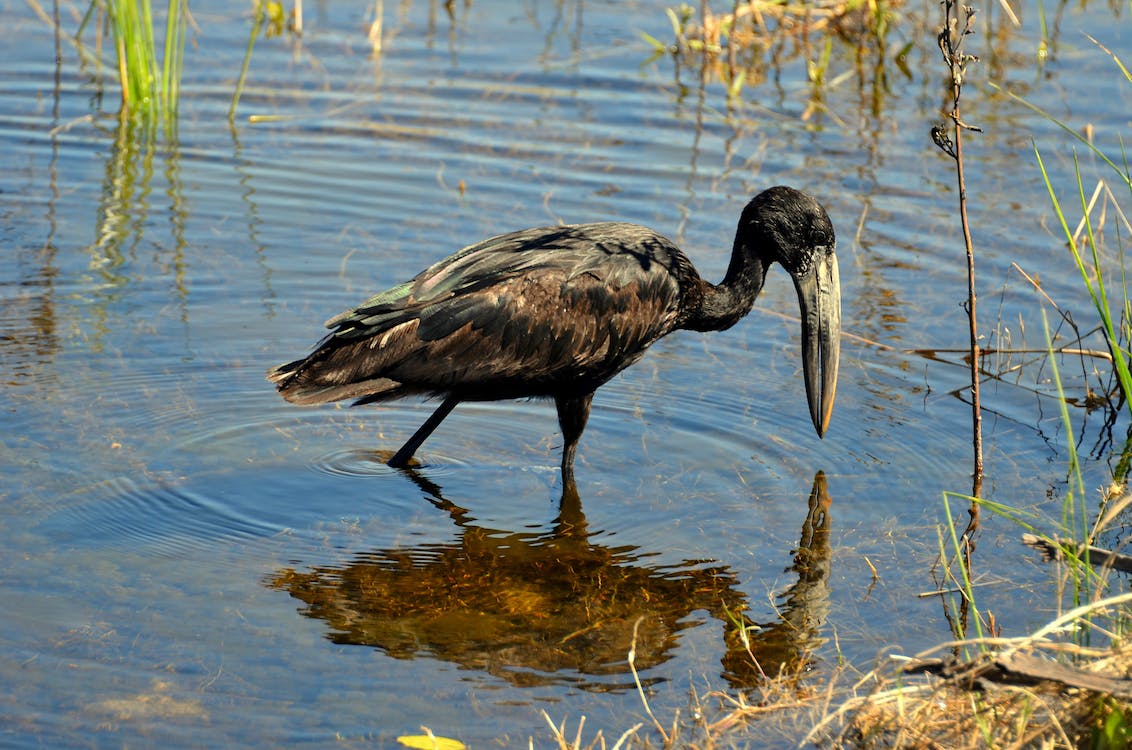It is a fairish-sized stork with an all-dark plumage, accentuated by a greenish gleam, and a distinctly-shaped bill, which produces a gap between half of its bill. It thrives in swamps, lakes, pans, and other still water habitats, feeding primarily on snails and mussels. Its flight is hefty and slow. Long neck and feet make it distinguishable from other darkish waterbirds.
Read further to know more about the African Openbill.
What is an African Openbill?
African openbill (Anastomus lamelligerus) is a stork species belonging to the Ciconiidae family. It is native to a wide range of sub-Saharan Africa. Like its close cousin from the genus Anastomus, the Asian Openbill, this bird species has a distinct bill that has well-adapted to both species’ feeding habits.
Its seven levels of classification are as follows:
Kingdom: Animalia
Phylum: Chordata
Class: Aves
Order: Ciconiiformes
Family: Ciconiidae
Genus: Anastomus
Species: A. lamelligerus
African Openbill Physical Description
African Openbill is a fairish-sized stork, 31.4 to 37 inches, weighing from 1000 to 1300 grams. It has an all-dark plumage with a greenish sheen and purple or brownish gleam on the breast and mantle. Eyes have a grayish tone, bluish lores, and a naked eye-ring. Legs and feet are darkish. The bill is brownish, which gets duller towards the base. Its shape is unique, as the mandibles have a wide gap that joins at the tip. Columnar pads are also present, allowing the bird to extract molluscs or snails.
Where can they be spotted?
African Openbill Storks occur in sub-Saharan Africa, thriving in freshwater habitats, such as wetlands, marshes, lakes, rivers, swamps, flooded plains, lagoons, mudflats, dams, and rice fields. Typically, they can be found in locations wherever molluscan prey is available.
Interesting Facts You Should Know About the African Openbill
African Openbill’s diet almost exclusively revolves on freshwater mussels and snails, feeding solely or in small groups. Its distinct bill has adapted to its unique feeding preference. The bill is used in detecting and prying their prey open.
This bird catches food items in the gap between the mandibles and then uses it to remove the prey’s operculum or protective lid before extracting the molluscs. However, it may also consume other food items, such as worms, fish, frogs, and large insects.
Sometimes, it can also be seen near a grazing hippopotamus, waiting and looking for snails disturbed by the huge mammal. Piles of shells often build up in its foraging grounds, as this bird tends to return to the same feeding site.
The species’ breeding season usually begins before, at the start, or late of the rainy season, where snails are emergent. African Openbills are highly gregarious during their breeding period, performing greeting and advertising displays, accompanied by bill-clattering.
Coupling happens during the nest construction stage, normally on the nest site itself. These birds nest in colonies, situated in trees above water, and occasionally, in reedbeds. The nest is made of reeds and sticks, with the interior lined with leaves, grass, and sedges.
The female African Openbill usually lays a clutch of 3-4 eggs, which both sexes incubate for around 25-30 days. Broods will be fed and cared for by the parents, eventually fledging about 50 to 55 days after they hatched.
While its population appears decreasing, the African Openbills are currently classified as Least Concern under the IUCN Red List of Threatened Species.
WILDLIFE PARKS AND RESERVES WHERE THIS SPECIES IS FOUND:
BOTSWANA
SOUTH AFRICA
Kalahari Gemsbok National Park
NAMIBIA
ZAMBIA
ZIMBABWE
BOTSWANA BIRDS | SOUTH AFRICA BIRDS
NAMIBIA BIRDS | ZAMBIA BIRDS | ZIMBABWE BIRDS

